Backpacking Fishing Pole: The Ultimate Guide for Enthusiasts
1. Introduction
Hey there, fellow adventurer! If you’re like me and love the thrill of hiking through the wilderness while dreaming of catching your dinner straight from a pristine stream or lake, then you’re in for a treat. Today, I’m diving deep into the world of the backpacking fishing pole. We’ll explore what makes these poles special, how to choose the best one, and even some top picks from Amazon. So, let’s get started!
What is a Backpacking Fishing Pole?
A backpacking fishing pole is specifically designed for portability and convenience, making it easy to carry along on your hiking or camping trips. Unlike traditional fishing rods, these poles are lightweight, compact, and often telescopic, allowing them to fit neatly in your backpack without taking up too much space.
Why Choose a Backpacking Fishing Pole?
Choosing a backpacking fishing pole over a regular fishing rod can make all the difference in your outdoor adventure. Imagine trekking through the mountains or forests, knowing you can stop by any water body and start fishing without lugging around heavy gear. It’s all about convenience and maximizing your outdoor experience.
2. Benefits of Using a Backpacking Fishing Pole
When it comes to blending the thrill of backpacking with the joy of fishing, a backpacking fishing pole is an essential piece of gear. These specialized poles offer several advantages that make them perfect for outdoor enthusiasts who love to fish. Let’s dive deeper into the benefits of using a backpacking fishing pole.
Lightweight and Portable
One of the standout features of a backpacking fishing pole is its lightweight design. These poles are crafted to be light as a feather, which means you can carry them in your pack without feeling burdened by extra weight. Here’s why the lightweight nature is crucial:
- Ease of Carrying: When you’re hiking long distances, every ounce counts. A lightweight fishing pole ensures you can bring your fishing gear along without sacrificing comfort or endurance.
- Compact Storage: Backpacking fishing poles are designed to be compact. They can collapse or break down into smaller sections, fitting easily into tight spaces within your backpack. This compactness is ideal for maximizing your packing efficiency and keeping your gear organized.
Versatility in Fishing
Backpacking fishing poles are incredibly versatile, capable of handling a wide range of fishing scenarios. Whether you’re casting a line into a small mountain stream or a larger lake, these poles can adapt to your needs. Here’s how they achieve this versatility:
- Adjustable Length: Many backpacking fishing poles are telescopic, meaning they can extend and retract to various lengths. This adjustability allows you to tailor the pole to different fishing environments, making it suitable for both close-range and long-distance casting.
- Multi-Piece Construction: Some poles come in multiple pieces that you can assemble and disassemble. This feature not only aids in portability but also lets you customize the pole’s length and action based on your fishing requirements.
- Wide Range of Applications: These poles are suitable for different types of fishing, from fly fishing in fast-moving streams to spin fishing in calm lakes. Their adaptability ensures you can target various fish species and habitats with ease.
Ease of Use
Another significant advantage of backpacking fishing poles is their user-friendly design. These poles are engineered to be simple to set up and use, even if you’re a beginner. Here’s why they are easy to handle:
- Quick Assembly: Most backpacking fishing poles can be set up in a matter of minutes. Their straightforward assembly process means you can spend more time fishing and less time figuring out complicated gear.
- Beginner-Friendly Features: Many models include features like pre-spooled reels, clear instruction manuals, and ergonomic handles that make them accessible to newcomers. These features help eliminate the learning curve and make fishing enjoyable from the get-go.
- Smooth Operation: The design of these poles often incorporates elements that enhance the fishing experience, such as smooth reel actions, comfortable grips, and durable materials. These features contribute to a hassle-free and enjoyable fishing experience, allowing you to focus on the thrill of the catch.
3. How to Choose the Best Backpacking Fishing Pole

Choosing the right backpacking fishing pole can make or break your outdoor fishing experience. With so many options on the market, it’s essential to understand what features to look for to ensure you get a pole that meets your needs. Here’s a detailed guide to help you select the best backpacking fishing pole.
Consider the Length and Weight
The length and weight of a backpacking fishing pole are crucial factors to consider. They directly affect the pole’s portability and functionality.
Length:
- Shorter Poles: Easier to carry and more compact, making them ideal for backpacking. However, they may limit your casting distance, which can be a drawback in certain fishing situations.
- Longer Poles: Provide better casting distance and control, but can be more cumbersome to carry.
Finding the Balance:
- Aim for a pole that balances portability and functionality. Typically, a pole around 6 to 7 feet offers a good compromise, providing sufficient casting distance while remaining manageable to carry.
Weight:
- Lightweight Poles: Easier to transport and less tiring to use over extended periods. Look for materials like graphite or carbon fiber, which offer strength without added weight.
- Heavy Poles: While they may offer more durability, they can be cumbersome and may not be ideal for long backpacking trips.
Material Matters
The material of your backpacking fishing pole affects its performance, durability, and weight. The three most common materials are graphite, fiberglass, and composite.
Graphite:
- Lightweight: Ideal for long hikes as it won’t weigh you down.
- Sensitive: Excellent for detecting subtle bites, making it easier to catch fish.
- Durable: Generally more expensive, but worth the investment for serious anglers.
Fiberglass:
- Durable: Can withstand a lot of wear and tear, making it a good choice for rugged environments.
- Flexible: Offers a smooth, forgiving bend, which can be beneficial when reeling in larger fish.
- Heavier: More substantial than graphite, which may be a consideration for backpackers looking to minimize weight.
Composite:
- Balanced: Combines the best features of graphite and fiberglass.
- Versatile: Suitable for a variety of fishing situations.
- Moderate Weight: Typically offers a good balance between weight and durability.
Telescopic vs. Traditional Poles
When it comes to backpacking fishing poles, you generally have two choices: telescopic poles and traditional multi-piece poles.
Telescopic Poles:
- Ultra-Portable: Collapse into themselves, making them incredibly compact and easy to carry.
- Quick Setup: Can be extended and collapsed quickly, which is convenient for spontaneous fishing stops.
- Durability: While modern designs are quite robust, they may not be as durable as traditional multi-piece poles.
Traditional Multi-Piece Poles:
- Stable: Break down into sections, providing a more stable and reliable fishing experience.
- Durable: Often more durable than telescopic poles due to their solid construction.
- Less Convenient: Slightly more cumbersome to transport and assemble compared to telescopic options.
Action and Power
Understanding the action and power of a backpacking fishing pole is essential for choosing the right one for your fishing needs.
Action:
- Fast Action: Bends mostly at the tip, offering quick responses and better control. Ideal for fishing in conditions where quick hook sets are necessary.
- Medium Action: Bends in the middle of the rod, providing a balance between flexibility and control. Suitable for a variety of fishing situations.
- Slow Action: Bends throughout the entire rod, offering maximum flexibility. Best for fishing with live bait or small lures.
Power:
- Ultralight: Best for small fish and delicate presentations. Great for trout or panfish.
- Light: Versatile, suitable for small to medium fish.
- Medium: Good all-around power for various species.
- Heavy: Best for large fish and heavy lures. Suitable for bass or pike.
Handle Comfort
The handle of your backpacking fishing pole is an often-overlooked feature that significantly affects your fishing comfort and experience.
Handle Materials:
- Cork: Lightweight, comfortable, and offers a good grip even when wet. Provides a classic feel.
- EVA Foam: Durable, comfortable, and resistant to wear and tear. Offers excellent grip and is easy to clean.
Comfort Considerations:
- Choose a handle that feels comfortable in your hand, as you’ll be holding it for extended periods.
- Ergonomic designs can reduce fatigue and improve your overall fishing experience.
4. Top Backpacking Fishing Poles on Amazon
Alright, let’s get into the nitty-gritty. Here are some of the top backpacking fishing poles you can find on Amazon, each offering unique features to enhance your fishing adventures.
KastKing Blackhawk II Telescopic Fishing Rod
The KastKing Blackhawk II Telescopic Fishing Rod is designed for anglers who value performance, portability, and convenience. This rod combines high-quality materials with innovative design features, making it a versatile choice for various fishing scenarios.
Pros:
- Performance Technology: The KastFlex Toray 24-Ton Carbon Matrix blank and solid glass tip provide unmatched durability, sensitivity, and performance. It feels like a one-piece rod despite being telescopic.
- Multi-Purpose: Available in 14 lengths and actions, this rod caters to both freshwater and saltwater fishing, from trout to inshore species.
- Convenient Design: The telescopic nature allows for easy travel and quick setup, saving valuable fishing time.
- Quality Components: Stainless steel line guides, graphite reel seats, and comfortable EVA handles enhance the overall quality and user experience.
- Quick Assembly: Easy to extend and collapse, making it user-friendly even for beginners.
Cons:
- Durability Concerns: Some users have mixed opinions about the rod’s long-term durability.
- Heavier Build: Compared to some other telescopic rods, it may feel slightly heavier.
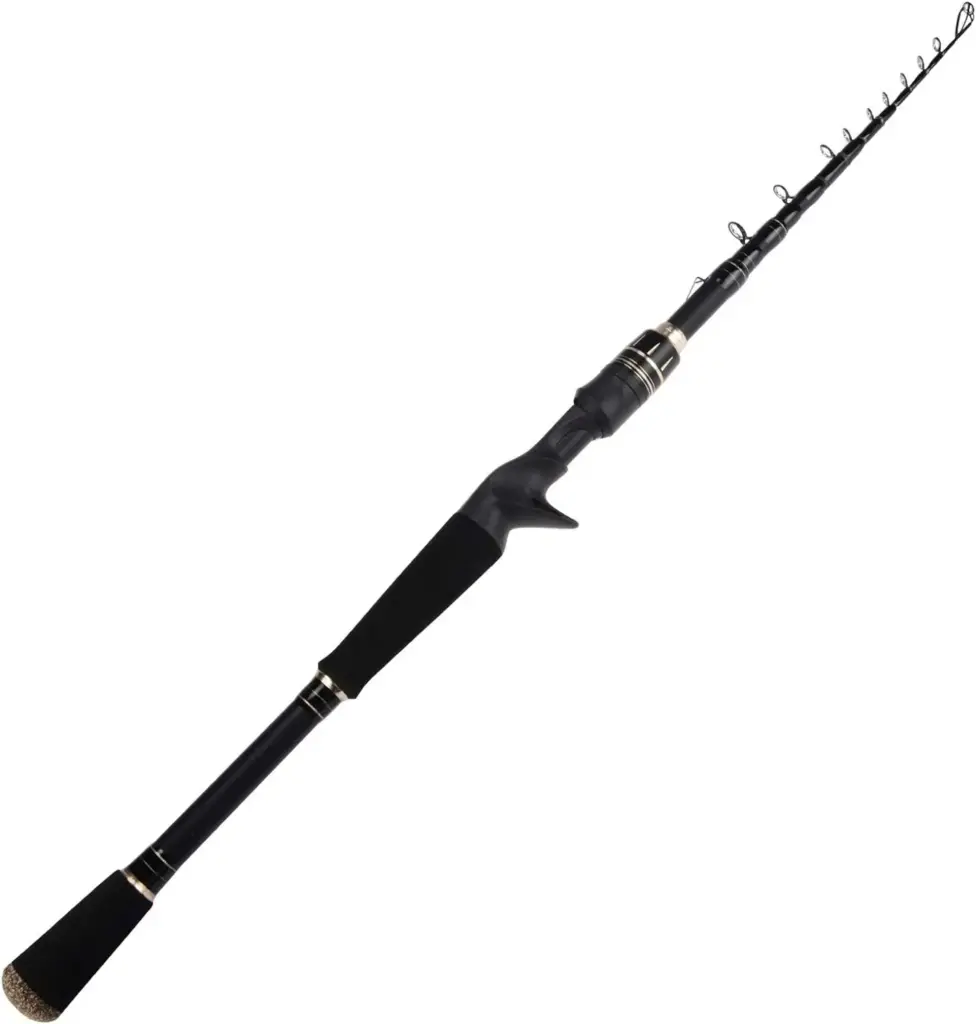
PLUSINNO Fishing Rod and Reel Combo
The PLUSINNO Fishing Rod and Reel Combo is a popular choice among anglers for its affordability, performance, and ease of use. This combo is designed to offer a complete fishing experience right out of the box, making it ideal for beginners and seasoned anglers alike.
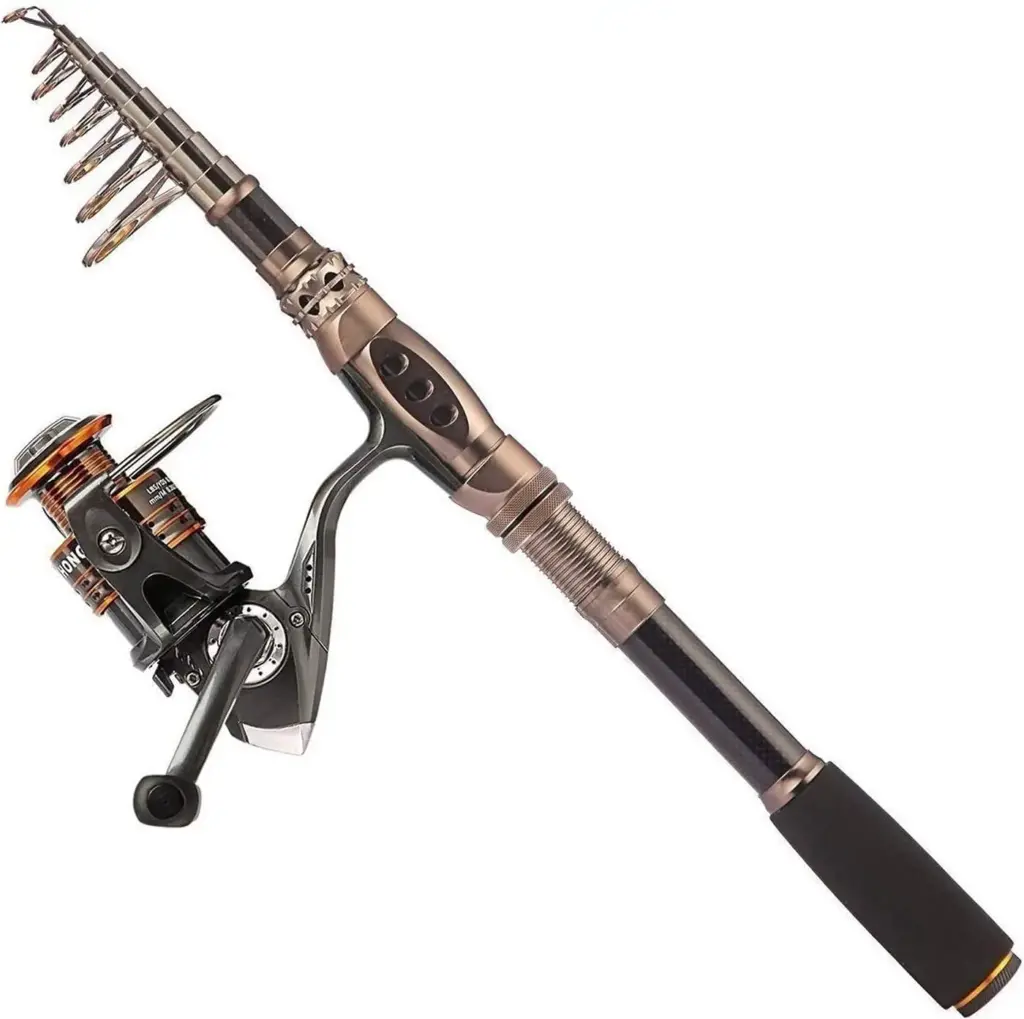
Pros:
- Affordable: At a lower price point, it provides excellent value for money, making it accessible for a wide range of users.
- High-Quality Materials: Made from high-density carbon fiber mixed with fiberglass, the rod is both hard and durable.
- Comfort and Convenience: Features a stainless steel hooded reel seat to resist seawater corrosion and an EVA fore grip for added comfort. The telescopic design ensures portability.
- Power and Performance: Equipped with instant anti-reverse and power drive gears for high strength. The deep aluminum spool and large line capacity enhance its functionality.
- Versatile Usage: Suitable for both freshwater and saltwater fishing, offering flexibility for various fishing conditions.
Cons:
- Mixed Quality Reviews: Some users have noted inconsistencies in the build quality.
- Reel Inclusion: The product includes only the rod and reel, with no lures or line, which might require additional purchases.
Sougayilang Fishing Rod Combos
The Sougayilang Fishing Rod Combos are designed for anglers who seek a complete, portable fishing kit. This set includes a telescopic fishing rod, spinning reel, carrier bag, and various accessories, making it a versatile choice for both saltwater and freshwater fishing.
Pros:
- Comprehensive Kit: Includes a telescopic fishing rod, spinning reel, carrier bag, lures, fishing line, and necessary accessories, providing everything needed for a fishing trip.
- Durable Construction: Made from high-density carbon fiber mixed with fiberglass, ensuring the rod is hard, durable, and lightweight.
- Smooth Reel: Features 13+1 corrosion-resistant ball bearings, a 5.5:1 gear ratio, and an interchangeable right or left-hand CNC machined aluminum handle for smooth operation.
- Portable: Lightweight and easily fits in a car trunk, boat, or backpack, making it convenient for travel.
- Customer Service: Offers a one-year worry-free service for any issues.
Cons:
- Mixed Durability Reviews: Some users have reported concerns about the durability of the rod.
- Quality Variability: Opinions are mixed on the overall quality and performance of the combo.
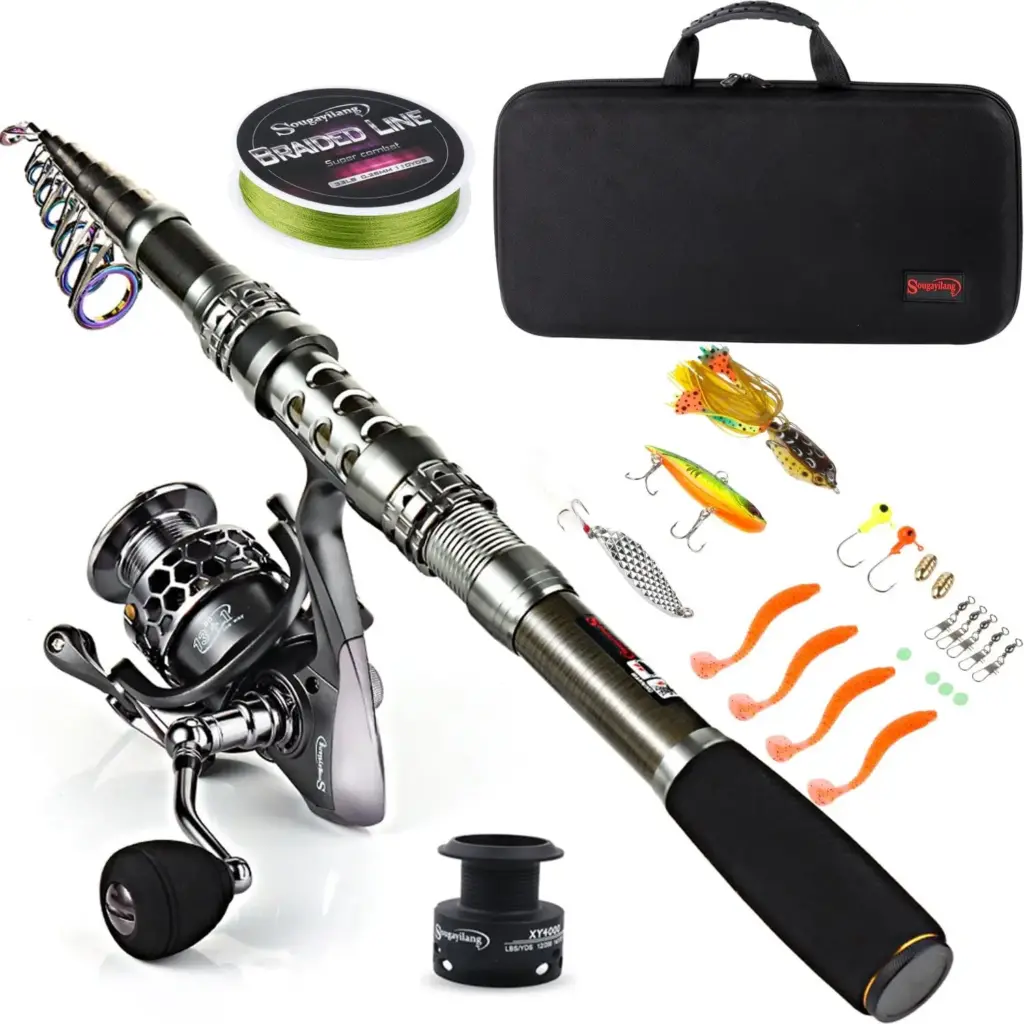
Ugly Stik GX2 Spinning Fishing Rod
The Ugly Stik GX2 Spinning Fishing Rod is known for its toughness and reliability. As the next generation of Ugly Stik rods, it offers improved balance and components while maintaining the brand’s legendary durability.
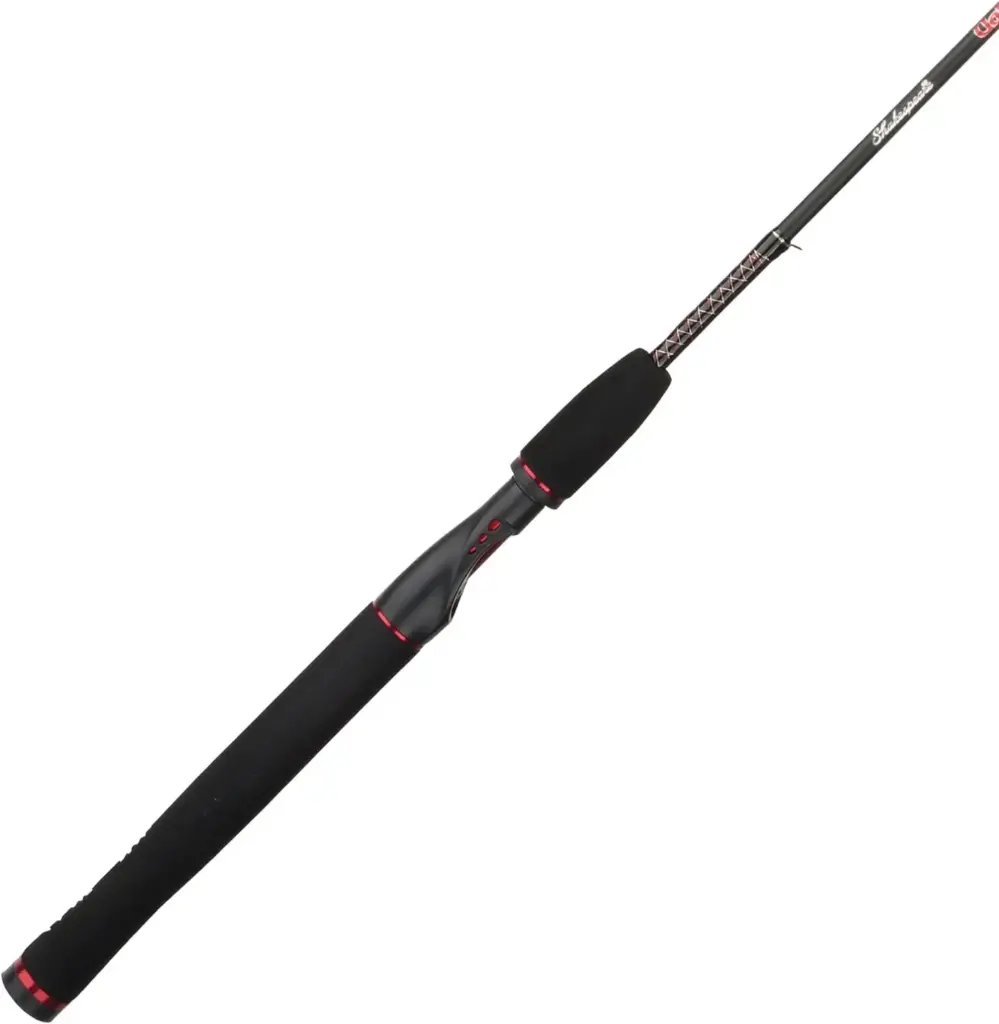
Pros:
- Durable Construction: Made from a blend of graphite and fiberglass, providing a lighter weight rod without sacrificing strength.
- Clear Tip Design: Features the Ugly Stik Clear Tip for added strength and sensitivity.
- Stainless Steel Guides: Six durable guides that resist corrosion and eliminate insert pop-outs.
- Comfortable Handle: Premium type-D EVA rod handle is lightweight and slip-resistant for a firm grip.
- Seven-Year Warranty: Covered by a lengthy warranty, ensuring long-term use and reliability.
Cons:
- Mixed Sensitivity Reviews: Some users feel the rod lacks sensitivity compared to other high-end options.
- Flexibility: Opinions vary on the flexibility of the rod, with some users finding it too stiff or too flexible.
Sougayilang Fly Fishing Rod Reel Combos
The Sougayilang Fly Fishing Rod Reel Combos offer a complete package for fly fishing enthusiasts. This set includes a fly rod, fly reel, fly line, backing and leader, and various accessories, all neatly packed in a carrier case.
Pros:
- Complete Package: Includes a 9-foot, 4-piece fly rod, fly reel, fly line, backing, leader, flies, and accessories, providing a comprehensive setup for fly fishing.
- High-Quality Materials: The fly rod is made from carbon fiber, with stainless steel guides and a comfortable cork handle. The reel is CNC-machined from aluminum alloy.
- Portable: The set comes with a convenient zippered case for easy transport and storage.
- Smooth Drag System: The fly reel features a smooth drag system with 2+1 ball bearings and a 1:1 gear ratio for efficient line control.
- Five-Year Warranty: Offers a five-year warranty, ensuring peace of mind for the user.
Cons:
- Alignment Issues: Some users have reported problems with the alignment of the rod sections.
- Mixed Ease of Use Reviews: Opinions are varied on the ease of use, fit, weight, and overall quality of the combo.

5. How to Use a Backpacking Fishing Pole
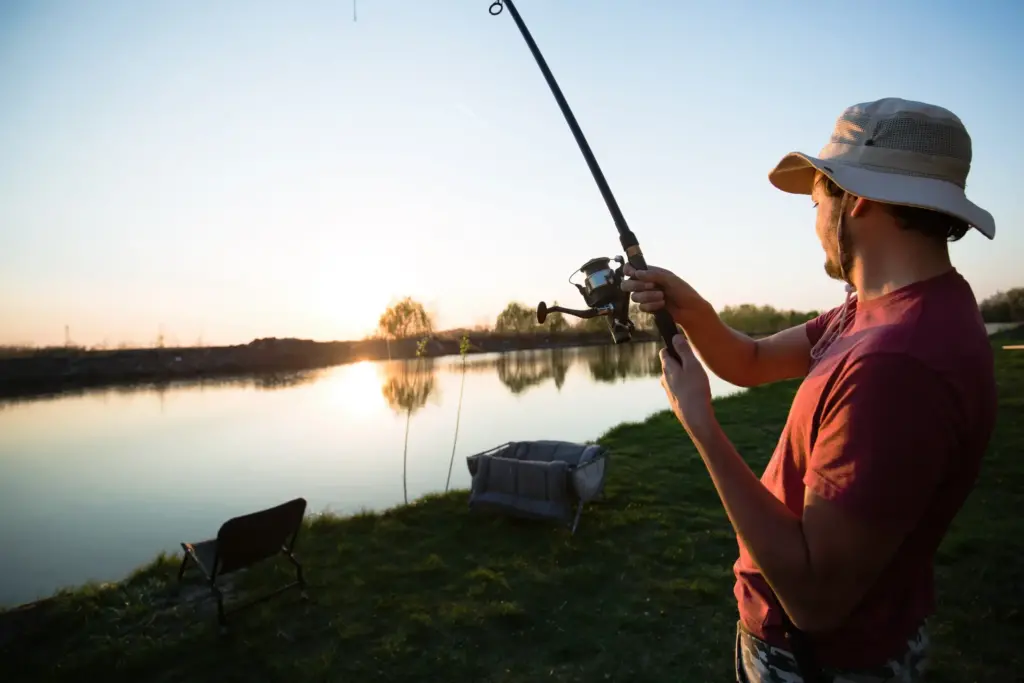
Using a backpacking fishing pole can be a straightforward and enjoyable experience, whether you’re a seasoned angler or a beginner. To help you get the most out of your gear, here’s a detailed guide on how to use a backpacking fishing pole effectively. This guide will cover everything from setting up your pole to mastering casting techniques, reeling in your catch, and maintaining your equipment.
Setting Up Your Pole
Setting up your backpacking fishing pole correctly is crucial for a smooth fishing experience. Here’s a step-by-step guide to ensure you get it right:
1. Unpack and Extend Your Pole:
- Carefully Unpack: Begin by removing your fishing pole from its case or packaging. Handle it gently to avoid damaging any components.
- Extend the Sections: If you’re using a telescopic pole, carefully extend each section one by one. Ensure each section is fully extended and securely locked in place before moving on to the next.
- Assemble Multi-Piece Poles: If your pole is a multi-piece design, connect each section by aligning the ferrules and pushing them together until they fit snugly. Ensure the guides are aligned properly to avoid tangling your line.
2. Attach Your Reel:
- Secure the Reel Seat: Most backpacking fishing poles have a reel seat at the base. Insert your reel into the seat and tighten the locking mechanism until the reel is firmly in place.
- Check for Stability: Give the reel a slight tug to ensure it’s securely attached and won’t come loose during use.
3. String the Pole:
- Thread the Line: Start by threading your fishing line through the guides, beginning at the tip of the pole and working your way down to the reel.
- Tie the Line: Once the line is threaded through all the guides, tie it to the reel spool and wind it onto the reel using the handle. Make sure the line is evenly distributed on the spool to prevent tangling.
Casting Techniques
Mastering your casting technique is essential for successful fishing. Here are some tips to help you cast like a pro:
1. Practice in an Open Area:
- Find a Safe Space: Before you hit the water, practice casting in an open area like a park or your backyard. This will help you get a feel for the pole and improve your technique without the pressure of catching fish.
- Start Slowly: Begin with short casts to get comfortable with the motion. Gradually increase your casting distance as you become more confident.
2. Smooth, Controlled Movements:
- Grip the Handle: Hold the pole with a relaxed yet firm grip. Your thumb should be on top of the handle, and your fingers should wrap around it comfortably.
- Backswing and Forward Cast: Start with the pole tip low and flick your wrist backward to create a backswing. As the pole reaches a vertical position, smoothly flick your wrist forward to cast the line out.
- Release at the Right Moment: Release the line at the peak of your forward swing to achieve maximum distance and accuracy.
Reeling in Your Catch
Once you’ve hooked a fish, the real fun begins. Here’s how to reel in your catch effectively:
1. Keep a Steady Hand:
- Maintain Control: Keep your hand steady and avoid jerking the pole. Sudden movements can cause the hook to dislodge and lose the fish.
- Use the Drag System: Adjust the drag on your reel to ensure the line doesn’t break. The drag system allows the line to be pulled out smoothly by the fish, reducing the risk of snapping.
2. Smooth, Consistent Reeling:
- Reel Slowly and Steadily: Use smooth, consistent motions to reel in your catch. This technique minimizes stress on the line and prevents the fish from escaping.
- Adjust as Needed: If the fish makes a sudden run, let it take some line and then start reeling again once it slows down.
Maintenance Tips
Proper maintenance of your backpacking fishing pole ensures it lasts longer and performs well. Here are some essential maintenance tips:
1. Rinse with Fresh Water:
- After Each Use: Rinse your pole and reel with fresh water after each use, especially if you’ve been fishing in saltwater. Saltwater can cause corrosion and damage to your equipment.
- Dry Thoroughly: Allow your pole to dry completely before storing it to prevent rust and mildew.
2. Regular Inspections:
- Check for Damage: Regularly inspect your pole for any signs of damage, such as cracks, chips, or loose guides. Address any issues promptly to avoid further damage.
- Lubricate Moving Parts: Apply a light lubricant to the reel and any moving parts to keep them functioning smoothly. This prevents rust and ensures a longer lifespan for your gear.
3. Proper Storage:
- Use a Protective Case: Store your pole in a protective case or sleeve to prevent damage during transport and storage.
- Avoid Extreme Temperatures: Store your fishing pole in a cool, dry place away from extreme temperatures, which can weaken the materials.
6. Helpful Tips for Backpacking Fishing
Backpacking fishing is an exhilarating way to combine the joys of hiking and fishing into one exciting adventure. To make the most of your trip, it’s essential to be well-prepared and knowledgeable. Here are some helpful tips for backpacking fishing, covering everything from choosing the right fishing spot to ensuring safety on your trip. Using a backpacking fishing pole can enhance your experience, so let’s dive into the details.
Choosing the Right Fishing Spot
Selecting the perfect fishing spot is crucial for a successful backpacking fishing trip. Here are some tips to help you find the ideal location:
Look for Clear Water and Visible Fish Activity:
- Clear Water: Clear water usually indicates a healthy ecosystem, which is likely to support a variety of fish species. Look for areas where you can see the bottom or observe fish swimming.
- Fish Activity: Pay attention to signs of fish activity such as ripples, jumping fish, or feeding behaviors. These are good indicators that the area is teeming with fish.
Consider the Time of Day:
- Early Mornings: Fish are often more active in the early morning when the water is cooler, and there is less human disturbance. This is a great time to catch fish that are feeding near the surface.
- Late Afternoons: As the day cools down, fish tend to become more active again. Late afternoons and early evenings can be productive times for fishing.
Research and Local Knowledge:
- Online Resources: Use online resources and fishing forums to research potential fishing spots in your backpacking area. Websites and apps can provide valuable information on the best locations and what fish species to expect.
- Talk to Locals: If you’re backpacking near a town or community, don’t hesitate to ask local anglers for advice. They can offer insights into the best fishing spots and techniques for the area.
Essential Gear to Bring
Having the right gear is essential for a successful backpacking fishing trip. Here’s a list of must-have items to ensure you’re well-prepared:
Lightweight Tackle Box:
- Variety of Lures and Baits: Bring a selection of lures and baits to cover different fishing scenarios. Include spinners, jigs, soft plastics, and live bait if possible.
- Compact Design: Choose a lightweight and compact tackle box that fits easily into your backpack without taking up too much space.
Extra Fishing Line and Hooks:
- Spare Line: Bring extra fishing line in case your line gets snagged or breaks. Monofilament and fluorocarbon lines are popular choices for their strength and flexibility.
- Additional Hooks: Pack a variety of hook sizes to match the different types of fish you might encounter. Circle hooks, J-hooks, and treble hooks are all useful options.
Portable Fish Finder:
- Finding Fish: A portable fish finder can be incredibly useful for locating fish in unfamiliar waters. These devices use sonar technology to detect fish and underwater structures, increasing your chances of a successful catch.
Multi-Tool and Pliers:
- Versatile Tool: A multi-tool with pliers, a knife, and scissors can handle various tasks, from cutting fishing line to removing hooks.
- Compact and Lightweight: Opt for a compact multi-tool that is easy to carry and doesn’t add unnecessary weight to your pack.
Appropriate Clothing and Accessories:
- Sun Protection: Wear a wide-brimmed hat, polarized sunglasses, and sunscreen to protect yourself from the sun’s harmful rays.
- Weather-Appropriate Clothing: Dress in layers to adjust to changing weather conditions. Waterproof clothing can keep you dry during unexpected rain showers.
Safety Tips for Backpacking and Fishing
Safety should always be a priority when embarking on a backpacking fishing trip. Here are some important safety tips to keep in mind:
Let Someone Know Your Itinerary:
- Inform Family or Friends: Always let someone know your planned route, destination, and expected return time. This ensures that someone is aware of your whereabouts in case of an emergency.
- Check-In Regularly: If possible, check in with your contact person periodically to update them on your progress and safety.
Pack a First Aid Kit:
- Basic Supplies: Bring a first aid kit with essential supplies such as bandages, antiseptic wipes, pain relievers, and any personal medications.
- Familiarize Yourself: Familiarize yourself with basic first aid procedures, including how to treat cuts, sprains, and insect bites.
Stay Hydrated:
- Bring Enough Water: Carry enough water for your trip and consider bringing a portable water filter or purification tablets to treat water from natural sources.
- Hydration Pack: A hydration pack can be a convenient way to carry water and stay hydrated while keeping your hands free for fishing.
Protect Yourself from the Elements:
- Sun Protection: Use sunscreen with a high SPF, wear protective clothing, and seek shade during the hottest parts of the day to avoid sunburn and heat exhaustion.
- Insect Protection: Apply insect repellent to protect yourself from mosquitoes and other biting insects. Long-sleeved shirts and pants can also help minimize bites.
Be Aware of Wildlife:
- Bear Safety: If you’re in bear country, carry bear spray and know how to use it. Store food and scented items in bear-proof containers or hang them out of reach.
- Respect Wildlife: Observe wildlife from a safe distance and avoid feeding or approaching animals. Keeping a respectful distance ensures both your safety and the animals’ well-being.
7. Conclusion
There you have it, folks! Backpacking fishing poles are an incredible addition to any outdoor enthusiast’s gear. They’re lightweight, portable, and versatile, making them perfect for spontaneous fishing trips during your hikes. Whether you’re a seasoned angler or a beginner, investing in a quality backpacking fishing pole can elevate your outdoor adventures. So, grab your gear, hit the trails, and may the fish be ever in your favor!
8. FAQs
- What makes a fishing pole suitable for backpacking?
A good backpacking fishing pole should be lightweight, compact, and easy to set up. Telescopic poles or multi-piece rods are ideal as they pack down small and are easy to transport. - How do I maintain my backpacking fishing pole?
Rinse your pole with fresh water after each use, especially if used in saltwater. Check for any signs of wear or damage regularly and store it in a protective case to prevent damage. - Can I use a backpacking fishing pole in saltwater?
Yes, but make sure to choose a rod with corrosion-resistant components like stainless steel guides and rinse it thoroughly after use to prevent rust. - What’s the best way to transport a fishing pole while backpacking?
Use a protective carrying case or sleeve to transport your fishing pole. Attach it securely to the outside of your backpack to save space inside. - Are telescopic fishing poles durable?
Telescopic fishing poles are generally durable but can be less robust than traditional multi-piece rods. Look for high-quality materials like carbon fiber to ensure longevity.
Resources
- https://fishingfount.com/bait-fishing-ultimate-guide/
- https://climbingcodex.com/mountaineering-the-ultimate-guide/
- https://fishingfount.com/fishing-shore-ultimate-guide




